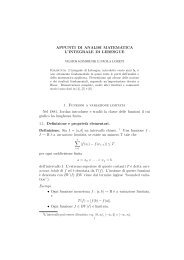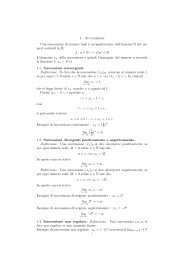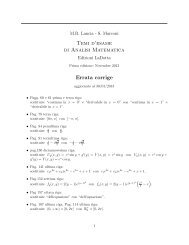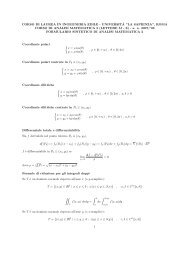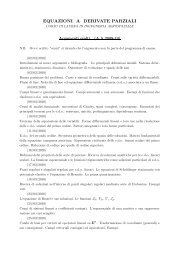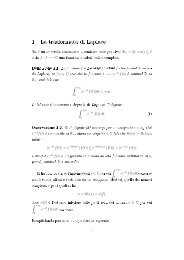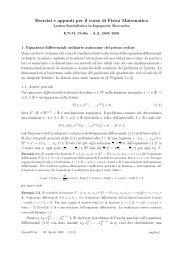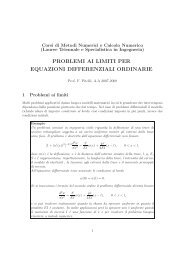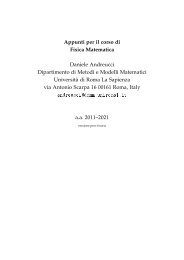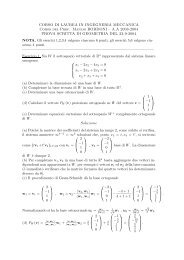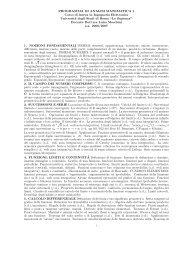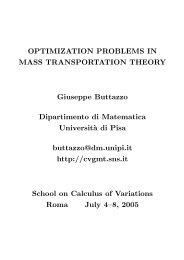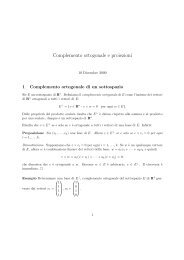- Page 1 and 2:
Equazioni alle derivate parzialiEse
- Page 3 and 4:
210. Edp del I ordine: metodo delle
- Page 5 and 6:
210. Edp del I ordine: metodo delle
- Page 7 and 8:
210. Edp del I ordine: metodo delle
- Page 9 and 10:
210. Edp del I ordine: metodo delle
- Page 11 and 12:
210. Edp del I ordine: metodo delle
- Page 13 and 14:
210. Edp del I ordine: metodo delle
- Page 15 and 16:
210. Edp del I ordine: metodo delle
- Page 17 and 18:
210. Edp del I ordine: metodo delle
- Page 19 and 20:
210. Edp del I ordine: metodo delle
- Page 21 and 22:
210. Edp del I ordine: metodo delle
- Page 23 and 24:
210. Edp del I ordine: metodo delle
- Page 25 and 26:
210. Edp del I ordine: metodo delle
- Page 27 and 28:
210. Edp del I ordine: metodo delle
- Page 29 and 30:
210. Edp del I ordine: metodo delle
- Page 31 and 32:
210. Edp del I ordine: metodo delle
- Page 33 and 34:
210. Edp del I ordine: metodo delle
- Page 35 and 36:
250. Edp del I ordine: trasformazio
- Page 37 and 38:
250. Edp del I ordine: trasformazio
- Page 39 and 40:
250. Edp del I ordine: trasformazio
- Page 41 and 42:
250. Edp del I ordine: trasformazio
- Page 43 and 44:
250. Edp del I ordine: trasformazio
- Page 45 and 46:
250. Edp del I ordine: trasformazio
- Page 47 and 48:
250. Edp del I ordine: trasformazio
- Page 49 and 50:
250. Edp del I ordine: trasformazio
- Page 51 and 52:
250. Edp del I ordine: trasformazio
- Page 53 and 54:
250. Edp del I ordine: trasformazio
- Page 55 and 56:
250. Edp del I ordine: trasformazio
- Page 57 and 58:
290. Edp del I ordine: modelli1) Di
- Page 59 and 60:
300. Equazione delle ondeQuindi, po
- Page 61 and 62:
300. Equazione delle ondee quindiα
- Page 63 and 64:
300. Equazione delle ondedovrebbero
- Page 65 and 66:
300. Equazione delle ondeSi noti ch
- Page 67 and 68:
310. Formula di D’AlembertSoluzio
- Page 69 and 70:
310. Formula di D’AlembertPerciò
- Page 71 and 72:
320. Formula di D’Alembert per pr
- Page 73 and 74:
320. Formula di D’Alembert per pr
- Page 75 and 76:
320. Formula di D’Alembert per pr
- Page 77 and 78:
320. Formula di D’Alembert per pr
- Page 79 and 80:
320. Formula di D’Alembert per pr
- Page 81 and 82:
320. Formula di D’Alembert per pr
- Page 83 and 84:
320. Formula di D’Alembert per pr
- Page 85 and 86:
350. Principio di Duhamel per l’e
- Page 87 and 88:
420. Applicazioni del principio di
- Page 89 and 90:
420. Applicazioni del principio di
- Page 91 and 92:
420. Applicazioni del principio di
- Page 93 and 94:
420. Applicazioni del principio di
- Page 95 and 96:
420. Applicazioni del principio di
- Page 97 and 98:
420. Applicazioni del principio di
- Page 99 and 100:
420. Applicazioni del principio di
- Page 101 and 102:
420. Applicazioni del principio di
- Page 103 and 104:
430. Applicazioni del principio di
- Page 105 and 106:
430. Applicazioni del principio di
- Page 107 and 108:
430. Applicazioni del principio di
- Page 109 and 110:
430. Applicazioni del principio di
- Page 111 and 112:
430. Applicazioni del principio di
- Page 113 and 114:
470. Semplici problemi al contorno
- Page 115 and 116:
470. Semplici problemi al contorno
- Page 117 and 118:
470. Semplici problemi al contorno
- Page 119 and 120:
470. Semplici problemi al contorno
- Page 121 and 122:
470. Semplici problemi al contorno
- Page 123 and 124:
480. Semplici problemi al contorno
- Page 125 and 126:
480. Semplici problemi al contorno
- Page 127 and 128:
480. Semplici problemi al contorno
- Page 129 and 130:
480. Semplici problemi al contorno
- Page 131 and 132:
480. Semplici problemi al contorno
- Page 133 and 134:
520. Formula di rappresentazione eq
- Page 135 and 136:
520. Formula di rappresentazione eq
- Page 137 and 138:
520. Formula di rappresentazione eq
- Page 139 and 140:
520. Formula di rappresentazione eq
- Page 141 and 142:
520. Formula di rappresentazione eq
- Page 143 and 144:
520. Formula di rappresentazione eq
- Page 145 and 146:
520. Formula di rappresentazione eq
- Page 147 and 148:
530. Formula di rappresentazione eq
- Page 149 and 150:
530. Formula di rappresentazione eq
- Page 151 and 152:
530. Formula di rappresentazione eq
- Page 153 and 154:
530. Formula di rappresentazione eq
- Page 155 and 156:
530. Formula di rappresentazione eq
- Page 157 and 158:
600. Teoria di Fourier600. Teoria d
- Page 159 and 160:
600. Teoria di Fourierove i numeri
- Page 161 and 162:
600. Teoria di Fourierove la succes
- Page 163 and 164:
605. Calcolo di serie di FourierR.2
- Page 165 and 166:
605. Calcolo di serie di FourierDat
- Page 167 and 168:
605. Calcolo di serie di FourierSi
- Page 169 and 170:
605. Calcolo di serie di Fouriernel
- Page 171 and 172:
605. Calcolo di serie di FourierInf
- Page 173 and 174:
605. Calcolo di serie di FourierIno
- Page 175 and 176:
610. Fourier equazione delle ondeR.
- Page 177 and 178:
610. Fourier equazione delle ondeQu
- Page 179 and 180:
610. Fourier equazione delle ondeR.
- Page 181 and 182:
610. Fourier equazione delle ondeSo
- Page 183 and 184:
610. Fourier equazione delle ondePe
- Page 185 and 186: 610. Fourier equazione delle ondeov
- Page 187 and 188: 610. Fourier equazione delle ondeov
- Page 189 and 190: 610. Fourier equazione delle ondePe
- Page 191 and 192: 610. Fourier equazione delle ondeSo
- Page 193 and 194: 610. Fourier equazione delle ondeR.
- Page 195 and 196: 610. Fourier equazione delle ondeQu
- Page 197 and 198: 610. Fourier equazione delle ondese
- Page 199 and 200: 610. Fourier equazione delle ondeCe
- Page 201 and 202: 620. Fourier equazione del calore d
- Page 203 and 204: 620. Fourier equazione del calore d
- Page 205 and 206: 620. Fourier equazione del calore d
- Page 207 and 208: 620. Fourier equazione del calore d
- Page 209 and 210: 620. Fourier equazione del calore d
- Page 211 and 212: 620. Fourier equazione del calore d
- Page 213 and 214: 620. Fourier equazione del calore d
- Page 215 and 216: 630. Fourier equazione di Laplaceco
- Page 217 and 218: 630. Fourier equazione di Laplace5.
- Page 219 and 220: 630. Fourier equazione di LaplaceSi
- Page 221 and 222: 630. Fourier equazione di LaplacePe
- Page 223 and 224: 630. Fourier equazione di Laplacee
- Page 225 and 226: 630. Fourier equazione di Laplaceov
- Page 227 and 228: 630. Fourier equazione di LaplaceIn
- Page 229 and 230: 630. Fourier equazione di Laplacech
- Page 231 and 232: 630. Fourier equazione di LaplaceCe
- Page 233 and 234: 820. Metodi dell’energia per equa
- Page 235: 910. Trasformata di Fourier: genera
- Page 239 and 240: 960. Trasformata di Laplace e risol



